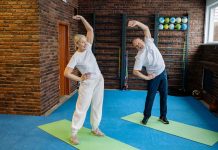Fitness Crisis Looming
THUNDER BAY – Are you old enough to remember Participation? At the time of the program’s start, the claim was that the average sixty-year-old Swede was more active and more fit than the average thirty-five-year-old Canadian.
Today that same claim could be true only for a far wider range of the population.
Physical activity among children and teens is lower than previously thought, and, in another surprise finding, young adults after the age of 20 show the only increases in activity over the lifespan, according to a study conducted by researchers from the Johns Hopkins Bloomberg School of Public Health.
“Activity levels at the end of adolescence were alarmingly low, and by age 19, they were comparable to 60-year-olds,” says the study’s senior author, Vadim Zipunnikov, assistant professor in the Bloomberg School’s Department of Biostatistics. “For school-age children, the primary window for activity was the afternoon between two and six P.M. So the big question is how do we modify daily schedules, in schools for example, to be more conducive to increasing physical activity?”
And, the study found, starting at age thirty-five, activity levels declined through midlife and older adulthood.
Getting into a new routine, including a new meal plan could be the impetus to jump-start a new lifestyle. Click here.
The study also identified different times throughout the day when activity was highest and lowest, across age groups and between males and females. These patterns, the researchers say, could inform programs aimed at increasing physical activity by targeting not only age groups but times with the least activity, such as during the morning for children and adolescents.

The findings, come amid heightened concern that exercise deficits are contributing to the growing obesity epidemic, particularly among children and teens.
For their study, the researchers used data from the National Health and Nutrition Examination Survey from the 2003-2004 and 2005-2006 survey cycles. The 12,529 participants wore tracking devices for seven straight days, removing them for only bathing and at bedtime. The devices measured how much time participants were sedentary or engaged in light or moderate-to-vigorous physical activity. The researchers broke down findings into five age groups: children (ages six to 11); adolescents (ages 12 to 19); young adults (ages 20 to 29); adults at midlife (ages 31 to 59); and older adults (age 60 through age 84). Forty-nine percent were male, the rest female.
Activity among 20-somethings, the only age group that saw an increase in activity levels, was spread out throughout the day, with an increase in physical activity in the early morning, compared to younger adolescents. The increase may be related to starting full-time work and other life transitions.
For all age groups, males generally had higher activity levels than females, particularly high-intensity activity, but after midlife, these levels dropped off sharply compared to females. Among adults 60 years and older, males were more sedentary and had lower light-intensity activity levels than females.
Health Guidelines Not Being Met
The study confirmed that the recommended guidelines were not being met. For instance, the World Health Organization (WHO) recommends at least 60 minutes of moderate-to-vigorous physical activity a day for children ages five to 17 years. The study found that more than 25 percent of boys and 50 percent of girls ages six to 11 and more than 50 percent of male and 75 percent of female adolescents ages 12 to 19 had not met the WHO recommendation.
While WHO formulates its recommendations in terms of moderate-to-vigorous activity, the researchers say there is a growing consensus for the benefits of reducing sedentary behavior and increasing even low-intensity levels of physical activity.
“The goal of campaigns aimed at increasing physical activity has focused on increasing higher-intensity exercise,” says Zipunnikov. “Our study suggests that these efforts should consider the time of day and also focus on increasing lower-intensity physical activity and reducing inactivity.”






